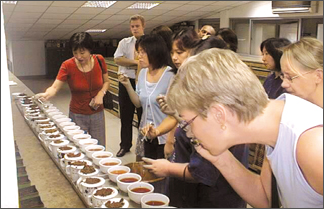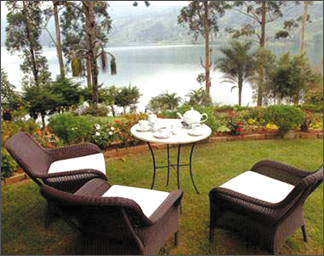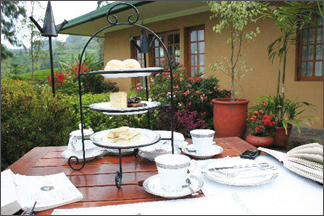Development and promotion of tea tourism
Vipula Wanigasekera
|

Tourists tasting local tea
|
It was in 2008 that the State Government in India introduced tea
tourism in North Bengal to attract both domestic and foreign tourists’
into tea plantation areas.
The idea translated into a plan and implementation following the
realization that tourists who visited Dooars areas had shown interest in
staying in the tea gardens and see how tea leaves are plucked and
processed apart from enjoying the serenity of lush green tea layers and
the scenic beauty.
Tea tourism is indeed practiced in Sri Lanka too but the potential in
the development of this segment is enormous with the strengths Sri Lanka
has over others.
What this article implies is to explore more avenues to develop Tea
Tourism in the mountains through public private partnership.
‘Ceylon Tea’ is a household name in almost all primary tourism
markets, secondary segments and market niches.
 |
 |
|
Those who visit
the country for relaxation can choose a location in lush green
tea
plantations where a tranquil ambience prevails. |
The professionals from production to Exports in the tea sector in the
country have spent their life time in careers in the promotion of ‘
Ceylon Tea’ irrespective of their respective brands and bulk form that
was exported for centuries.
The awareness on the ‘Ceylon Tea’ has already been established.
Buyers and consumers know where the tea comes from. Tourism needs to do
a little push to strengthen the ‘Tea Tourism’ being practiced today to
reap optimum results and benefits , particularly in the focused
marketing efforts for high-end, high spending visitors into the country.
It is interesting for tea drinkers in tourist markets to know how
their favourite ‘Ceylon tea’ reaches their kitchen shelves. Not many
would still know that this very cup of tea that relieves them of their
stress, goes through a gamut of production process before finally it is
blended, packeted and exported and reaches the household.
Primarily, the interest needs to be created to give potential
visitors ‘ a unique experience’.
The visitors need to be provided the opportunity of walking through
lavish plantations, learning about its history while staying at
comfortable tea bungalows with best of comforts, enjoying and
interacting with tea workers, trying out plucking tea leaves, and visit
to tea factories.
Most incentive travel groups are given this opportunity which needs
to be extended to other package tours and independent travelers.
The idea is similar to the practice of the European Wine Tourism
where the visitors are given a chance to go through the plantation and
production process to learn about the wines they taste in most
occasions.
Those who visit the country for relaxation can choose a location in
lush green tea plantations where a tranquil ambience prevails. Some call
it simply a heaven to get away from the rush world. Visitors will not
travel to mountains at the cost of the beaches with the ever increasing
arrivals. Only a wider choice is offered.
The added value is that some may opt to view the ‘sunrise’ from the
top of Adams Peak which is one of the most beautiful sights of its kind
with vivid colours and spectacular panoramic scene.
They would not miss the natural and man built lakes originating from
the hills including Castlereagh , Mousakelle, Kotmale, Samanalaweva,
Randenigala etc.
The enchanting natural water-falls also form the most beautiful
landscapes one can imagine. The strength is that the cold climes could
be reached within five hours from the hot and noisy capital. The
deliberations to revive the tourist trains to upcountry will not only
resolve the transport issue but also give this much sought after
experience to the visitors to up country.
Horton Plains was declared a National Park in 1988 and is the highest
plateau in the country. The highlight point ‘World’s End’ is visited by
a large number of locals that is desirable to make ‘a must visit place’
for tourists too.
Horton Plains is surrounded by the best tea growing areas in Uva to
the east, Balangoda to the south, Dimbula to the west and Nuwara Eliya
Planting region to the north.
Another strength is that tea tourism can be targeted to those who
specially visit the country to witness the life during the British era.
A segment of affluent Indians for instance, aspire to experience ‘a
bit of life style’ of then Britishers who were entrusted to look after
the tea plantations.
Tailored, set up and trained personnel can offer this experience in
colonial bungalows.
Having said that, with the large number of attractions and locations
in the country, it may be difficult to make over emphasis to one area in
an overall approach for sustainable tourism development. But the time is
opportune to look at these segments for several reasons.
It is envisaged that optimum spread of tourism throughout the country
in which the Tea Tourism is definitely a potential for further
development.
The scenic beauty of the country can truly be seen on a journey to up
country which would contribute largely to tourists saying Sri Lanka is
truly a beautiful country.
Promotional efforts can ride on ‘Ceylon Tea’ which is a known brand.
What is emphasized is to strengthen the strategy to offer the visitor an
experience which would be taken back as a memory to be shared among the
friends and relatives. This is a credible source of communication over
all other modes and methods.
Last and not the least, Tea Tourism will cascade down the economic
benefits to peripherals from the ‘ young ones’ who sell the beautiful
flowers to the by passers to suppliers to hotels and other accommodation
facilities, who are very much part of stakeholders of Tourism Industry
in the country.
|



